A FEM-Based Comparative Study of the Effect of Rotor Bar Designs on the Performance of Squirrel Cage Induction Motors
Abstract
:1. Introduction
- The effect of single-cage and double-cage rotor structures in different slot combinations on the induction motor has been examined;
- The effects of aluminum and copper cage structures on various slot number combinations in the induction motor have been compared;
- The impact of different rotor slot numbers on motor performance has been analyzed while keeping the same stator;
- Changes in starting torque due to both cage material and rotor slot number and structure have been obtained;
- The effects of different slot combinations on the output torque have been compared using FEM;
- Output torque ripple values obtained from different slot combinations have been obtained and compared;
- While the effects of single-cage and double-cage slot structures are well known, the changes that may arise from different slot number combinations and different cage materials have been comprehensively presented.
2. Design Considerations
3. Initial Model and Specifications of Proposed IM
4. Comparison of Single and Double-Cage Rotor Designs
4.1. Single-Cage Rotor with Different Numbers of Slots
4.2. Double-Cage Rotor with Different Numbers of Slots
4.3. Effect of Rotor Cage Material with Different Combinations
5. Performance Comparison of the Designs
6. Evaluation and Conclusions
- In the single and double cages, the starting torque value increased when the number of rotor slots increased, and the number of stator slots remained constant;
- The double-cage rotor motor had a higher starting torque value than the single-cage rotor motor, which has the same number of stator slots/rotor slots as expected, and a difference between the rotor slot numbers is obtained;
- The double-cage designs have higher torque ripples than single-cage designs in all the same combinations;
- As given in the 36/34 combination, some combinations should be avoided due to high ripples. Output torque waveforms should be verified by FEM simulations;
- The improved design has an approximately 8 °C lower T2 due to better cooling performance as a result of a higher number of rotor slots. The study contributes that the designs with a higher number of rotor slots exhibit better cooling performance even if they have the same stator winding, housing, and cooling air speed;
- In the motor with aluminum squirrel-cage material, the loss of the rotor winding was higher than that of the copper one. However, copper cage injection is too costly, and aluminum alternatives are still more popular, both in design preference and production. So, optimal design studies closest to copper performance are still attractive;
- The requirements of the motors operating from the mains and the VFD are different from each other. For this reason, induction motors that work with VFDs should be designed with single-cage rotors to avoid additional losses that cause lower efficiency.
Funding
Data Availability Statement
Conflicts of Interest
References
- Pareek, A.; Dom, R.; Gupta, J.; Chandran, J.; Adepu, V.; Borse, P.H. Insights into renewable hydrogen energy: Recent advances and prospects. Mater. Sci. Energy Technol. 2020, 3, 319–327. [Google Scholar] [CrossRef]
- Zhong, Z.; Zhang, Y.; Wang, S.; Deng, C.; Zhang, Y. Economic dispatch model based on time-of-use electricity price for photovoltaic systems. Arab. J. Sci. Eng. 2018, 43, 2961–2970. [Google Scholar] [CrossRef]
- Chan, C.C.; Bouscayrol, A.; Chen, K. Electric, Hybrid, and Fuel-Cell Vehicles: Architectures and Modeling. IEEE Trans. Veh. Technol. 2010, 59, 589–598. [Google Scholar] [CrossRef]
- Zeraoulia, M.; Benbouzid, M.E.H.; Diallo, D. Electric Motor Drive Selection Issues for HEV Propulsion Systems: A Comparative Study. IEEE Trans. Veh. Technol. 2006, 55, 1756–1764. [Google Scholar] [CrossRef]
- Sun, X.; Shi, Z.; Lei, G.; Guo, Y.; Zhu, J. Analysis and design optimization of a permanent magnet synchronous motor for a campus patrol electric vehicle. IEEE Trans. Veh. Technol. 2019, 68, 10535–10544. [Google Scholar] [CrossRef]
- Park, H.J.; Lim, M.S. Design of high-power density and high efficiency wound-field synchronous motor for electric vehicle traction. IEEE Access 2019, 7, 46677–46685. [Google Scholar] [CrossRef]
- Ehsani, M.; Gao, Y.; Gay, S. Characterization of electric motor drives for traction applications. In Proceedings of the 29th Annual Conference of the Industrial Electronics Society, Roanoke, VA, USA, 2–6 November 2003; pp. 891–896. [Google Scholar]
- Nanda, G.; Kar, N.C. A survey and comparison of characteristics of motor drives used in electricS vehicles. In Proceedings of the Canadian Conference on Electrical and Computer Engineering, Ottawa, ON, Canada, 7–10 May 2006; pp. 811–814. [Google Scholar]
- Damiano, A.; Gatto, G.; Marongiu, I.; Porru, M.; Serpi, A. Real-time control strategy of energy storage systems for renewable energy sources exploitation. IEEE Trans. Sustain. Energy. 2014, 5, 567–576. [Google Scholar] [CrossRef]
- Dedid, C.; Soebagio, M.; Purnomo, M.H. Induction motor speed control with fast response using the Levenberg Marquardt method for electric cars. Int. J. Comput. Appl. Technol. 2012, 42, 14–18. [Google Scholar]
- Libbos, E.; Ku, B.; Agrawal, S.; Tungare, S.; Banerjee, A.; Krein, P. Variable-Pole Induction Machine Drive for Electric Vehicles. In Proceedings of the IEEE International Electric Machines & Drives Conference, San Diego, CA, USA, 12–15 May 2019; pp. 515–522. [Google Scholar]
- Ocak, C.; Yenipınar, B. Investigation of the Effects of Hybrid-Structured Rotor Windings on Efficiency and Performance of Induction Motor. Eur. J. Sci. Technol. 2021, 26, 242–246. [Google Scholar]
- Xue, X.D.; Cheng, K.W.E.; Cheung, N.C. Selection of electric motor drives for electric vehicles. In Proceedings of the Australasian Universities Power Engineering Conference, Sydney, Australia, 14–17 December 2008; pp. 170–175. [Google Scholar]
- Guzinski, J.; Abu-Rub, H. Sensorless induction motor drive for electric vehicle application. Int. J. Eng. Sci. Technol. 2010, 2, 20–34. [Google Scholar] [CrossRef]
- Kim, K.T.; Song, H.E.; Park, G.S. A study on the design of induction motor in low speed urban electric vehicle. In Proceedings of the IEEE Transportation Electrification Conference and Expo, Dearborn, MI, USA, 27–29 June 2016; pp. 1–4. [Google Scholar]
- Li, K.; Cheng, G.; Sun, X.; Yang, Z.; Fan, Y. Performance optimization design and analysis of bearingless induction motor with different magnetic slot wedges. Results Phys. 2019, 12, 349–356. [Google Scholar] [CrossRef]
- Yahaya, E.A.; Omokhafe, T.; Agbachi, E.O.; James, A.G. Advantage of double cage rotor over single cage rotor induction motor. Innov. Syst. Des. Eng. 2015, 6, 1–4. [Google Scholar]
- Zhou, G.Y.; Shen, J.X. Current harmonics in induction machine with closed-slot rotor. IEEE Trans. Ind. Appl. 2017, 53, 134–142. [Google Scholar] [CrossRef]
- Gyftakis, K.N.; Kappatou, J. The impact of the rotor slot number on the behaviour of the induction motor. Adv. Power Electron. 2013, 2013, 1–9. [Google Scholar] [CrossRef]
- Masuku, T.M.; Wang, R.J.; Botha, M.C.; Gerber, S. Design strategy of traction induction motors. In Proceedings of the Southern African Universities Power Engineering Conference/Robotics and Mechatronics/Pattern Recognition Association of South Africa, Bloemfontein, South Africa, 28–30 January 2019; pp. 316–321. [Google Scholar]
- Wolnik, T.; Styskala, V.; Mlcak, T. Study on the Selection of the Number of Magnetic Poles and the Slot-Pole Combinations in Fractional Slot PMSM Motor with a High Power Density. Energies 2022, 15, 215. [Google Scholar] [CrossRef]
- Chasiotis, I.D.; Karvanas, Y.L.; Scuiller, F. Effect of Rotor Bars Shape on the Single-Phase Induction Motors Performance: An Analysis toward Their Efficiency Improvement. Energies 2022, 15, 717. [Google Scholar] [CrossRef]
- Elhaija, W.A.; Ghorbanian, V.; Faiz, J.; Nejadi-Koti, H. Significance of rotor slots number on induction motor operation under broken bars. In Proceedings of the IEEE International Electric Machines and Drives Conference, Miami, FL, USA, 21–24 May 2017. [Google Scholar]
- Park, H.J.; Hong, H.B.; Lee, K.D. A Study on a Design Considering the Transient State of a Line-Start Permanent Magnet Synchronous Motor Satisfying the Requirements of the IE4 Efficiency Class. Energies 2023, 15, 9644. [Google Scholar] [CrossRef]
- Ion, C.P.; Calin, M.D.; Peter, I. Design of a 3 kW PMSM with Super Premium Efficiency. Energies 2023, 16, 498. [Google Scholar] [CrossRef]
- Lu, C.; Yang, Z.; Sun, X.; Ding, Q. Design and Multi-Objective Optimization of a Composite Cage Rotor Bearingless Induction Motor. Electronics 2023, 12, 775. [Google Scholar] [CrossRef]
- Marfoli, A.; Nardo, M.D.; Degano, M.; Gerada, C.; Chen, W. Rotor Design Optimization of Squirrel Cage Induction Motor—Part I: Problem Statement. IEEE Trans. Energy Convers. 2021, 36, 1271–1279. [Google Scholar] [CrossRef]
- Nardo, M.D.; Marfoli, A.; Degano, M.; Gerada, C.; Chen, W. Rotor Design Optimization of Squirrel Cage Induction Motor—Part II: Results Discussion. IEEE Trans. Energy Convers. 2021, 36, 1280–1288. [Google Scholar] [CrossRef]
- Juhaniya, A.I.S.; Ibrahim, A.A.; Mohd Zainuri, M.A.A.; Zulkifley, M.A.; Remli, M.A. Optimal Stator and Rotor Slots Design of Induction Motors for Electric Vehicles Using Opposition-Based Jellyfish Search Optimization. Machines 2022, 10, 1217. [Google Scholar] [CrossRef]
- Nell, M.; Kubin, A.; Hameyer, K. Multi-Stage Optimization of Induction Machines Using Methods for Model and Parameter Selection. Energies 2021, 14, 5537. [Google Scholar] [CrossRef]
- Wogi, L.; Thelkar, A.; Tahiro, T.; Ayana, T.; Urooj, S.; Larguech, S. Particle Swarm Optimization Based Optimal Design of Six-Phase Induction Motor for Electric Propulsion of Submarines. Energies 2022, 15, 2994. [Google Scholar] [CrossRef]
- Tripathy, S.N.; Kundu, S.; Pradhan, A. Multi-Objective Optimization Technique Based Design of Squirrel Cage Induction Motor. In Proceedings of the 2022 2nd International Conference on Power Electronics & IoT Applications in Renewable Energy and Its Control (PARC), Mathura, India, 21–22 January 2022; pp. 1–6. [Google Scholar]
- Hannan, M.A.; Azidin, F.A.; Mohamed, A. Multi-sources model and control algorithm of an energy management system for light electric vehicles. Energy Convers. Manag. 2012, 62, 123–130. [Google Scholar] [CrossRef]
- International Electrotechnical Commission- IEC 60034-30-1 Ed.1: Rotating electrical machines—Part 30-1: Efficiency classes of line operated AC motors (IE code). 2014. Available online: https://webstore.iec.ch/publication/136 (accessed on 5 August 2023).
- Goman, V.; Prakht, V.; Kazakbaev, V.; Dmitrievskii, V. Comparative Study of Induction Motors of IE2, IE3 and IE4 Efficiency Classes in Pump Applications Taking into Account CO2 Emission Intensity. Appl. Sci. 2020, 10, 8536. [Google Scholar] [CrossRef]
- Kreveld, P. Don’t Rush In. Available online: https://electricalconnection.com.au/dont-rush-in/ (accessed on 5 August 2023).
- Ferreira, F.J.T.E.; Leprettre, B.; de Almeida, A.T. Comparison of Protection Requirements in IE2-, IE3-, and IE4-Class Motors. IEEE Trans. Ind. Appl. 2016, 52, 3603–3610. [Google Scholar] [CrossRef]
- Tomizawa, K.; Nagasawa, K.; Hayashi, Y.; Matsumoto, T. Low Starting Current Motor Developed for Top Runner Model. Meiden Rev. Ser. 2018, 172, 17–20. [Google Scholar]
- Technical Bulletin—WEG: Conform to IE3 Motors. Available online: https://www.mak.nl/pdfbrochures/WEG-technical-bulletin-weg-conform-to-ie3-motors-50059073-technical-article-english.pdf (accessed on 5 August 2023).
- Lee, G.; Min, A.; Hong, J.P. Optimal shape design of rotor slot in squirrel-cage induction motor considering torque characteristic. IEEE Trans. Magn. 2013, 49, 2197–2200. [Google Scholar] [CrossRef]
- Zhanh, D.; Park, C.S.; Koh, C.S. A new optimal design method of rotor slot of three-phase squirrel cage induction motor for NEMA class D speed-torque characteristic using multi-objective optimization algorithm. IEEE Trans. Magn. 2012, 48, 879–882. [Google Scholar]
- Lipo, T.A. Introduction to AC Machine Design; John Wiley & Sons: Hoboken, NJ, USA, 2017. [Google Scholar]
- Hase, Y.; Khandelwal, T.; Kameda, K. Power System Dynamics with Computer-Based Modeling and Analysis; John Wiley & Sons: Hoboken, NJ, USA, 2020. [Google Scholar]
- Available online: https://new.abb.com/motors-generators# (accessed on 5 August 2023).
- Dalcalı, A.; Ocak, C. Effect of different magnet materials on the performance of surface mounted direct drive PMSM. J. Aware. 2018, 3, 217–224. [Google Scholar] [CrossRef]
- Popescu, M.; Goss, J.; Staton, D.A.; Hawkins, D.; Chong, Y.C.; Boglietti, A. Electrical vehicles—Practical solutions for power traction motor systems. IEEE Trans. Ind. Appl. 2018, 54, 2751–2762. [Google Scholar] [CrossRef]
- Duan, Y. Method for Design and Optimization of Surface Mount Permanent Magnet Machines and Induction Machines. Ph.D. Dissertation, Georgia Institute of Technology, Atlanta, Georgia, 2010. [Google Scholar]
- Upadhyay, K.G. Design of Electrical Machines; New Age International Limited Publications: Delhi, India, 2011. [Google Scholar]
- Dalcalı, A.; Akbaba, M. Comparison of 2D and 3D magnetic field analysis of single-phase shaded pole induction motors. Eng. Sci. Technol. Int. J. 2016, 19, 1–6. [Google Scholar] [CrossRef]
- Ünlükaya, E.; Yetgin, A.G.; Çanakoğlu, A.I.; Turan, M. Effect of rotor slot shapes on induction motor performance. In Proceedings of the Symposium on Electrical-Electronic-Computer and Biomedical Engineering, Bursa, Türkiye, 27–29 November 2014; pp. 168–172. [Google Scholar]
- Besnerais, J.L.; Lanfranchi, V.; Hecquet, M.; Brochet, P. Optimal slot numbers combination for magnetic noise reduction in variable-speed induction motors. IEEE Trans. Magn. 2009, 45, 3131–3136. [Google Scholar] [CrossRef]
- Finley, W.R.; Hodowanec, M.M. Selection of copper vs. aluminum rotors for induction motors. In Proceedings of the Industry Applications Society Forty-Seventh Annual Petroleum and Chemical Industry Conference, San Antonio, TX, USA, 11–13 September 2000; pp. 1–11. [Google Scholar]
- Popescu, M.; Riviere, N.; Volpe, G.; Villani, M.; Fabri, G.; di Leonardo, L. A copper rotor induction motor solution for electrical vehicles traction system. In Proceedings of the IEEE Energy Conversion Congress and Exposition, Baltimore, MD, USA, 29 September–3 October 2019; pp. 3924–3930. [Google Scholar]
- Zhang, Q.; Liu, H.; Zhang, Z.; Song, T. A cast copper rotor induction motor for small commercial EV traction: Electromagnetic design, analysis, and experimental tests. CES Trans. Electr. Mach. Syst. 2018, 2, 417–424. [Google Scholar] [CrossRef]
- Gieras, J.F. Advancements in Electric Machines; Springer: Berlin/Heidelberg, Germany, 2008. [Google Scholar]
- Brush, E.F.; Cowie, J.G.; Peters, D.T.; Van Son, D.J. Die-cast copper motor rotors: Motor test results, copper compared to aluminum. Energy Effic. Mot. Driven Syst. 2003, 136–143. [Google Scholar] [CrossRef]
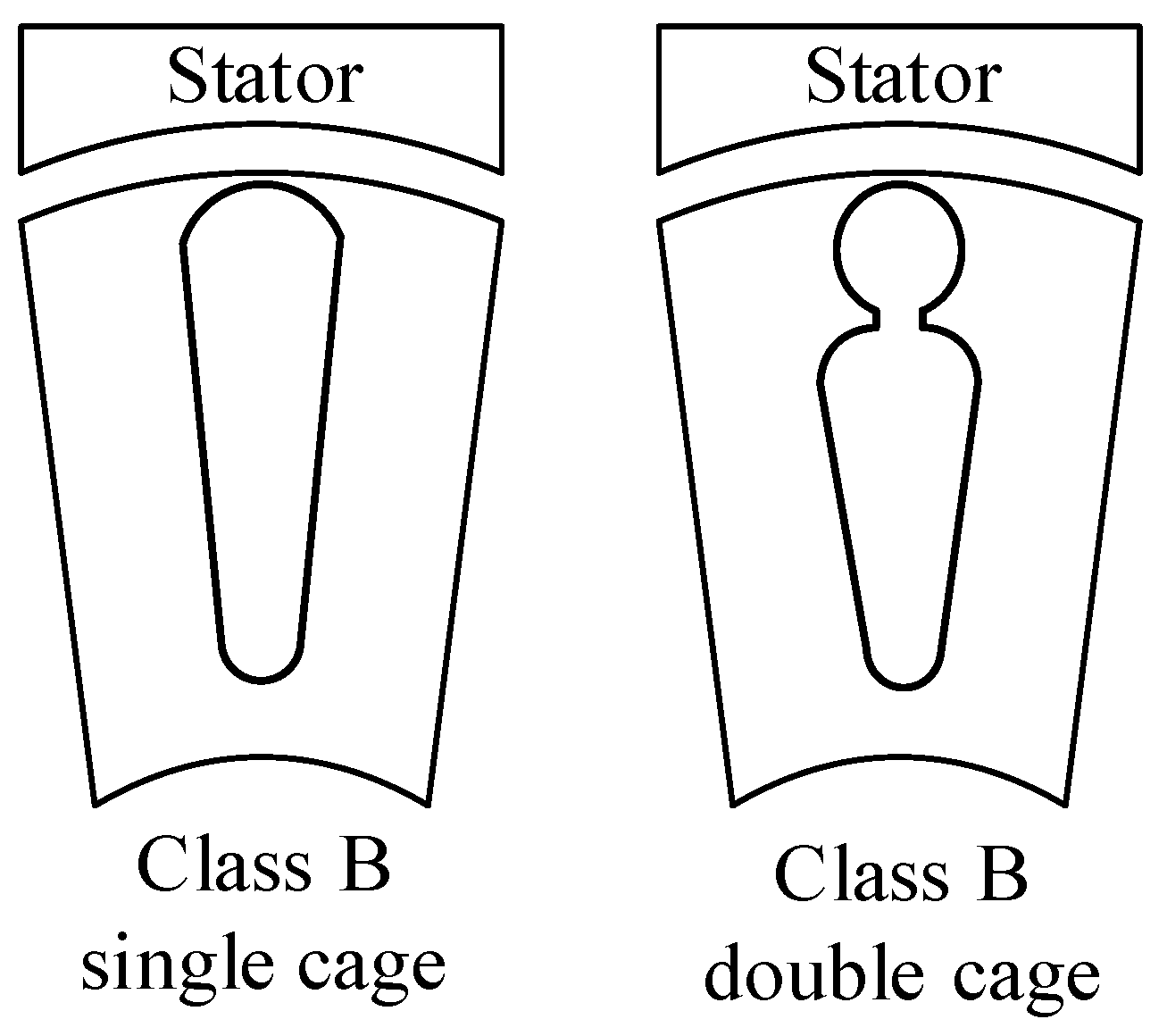
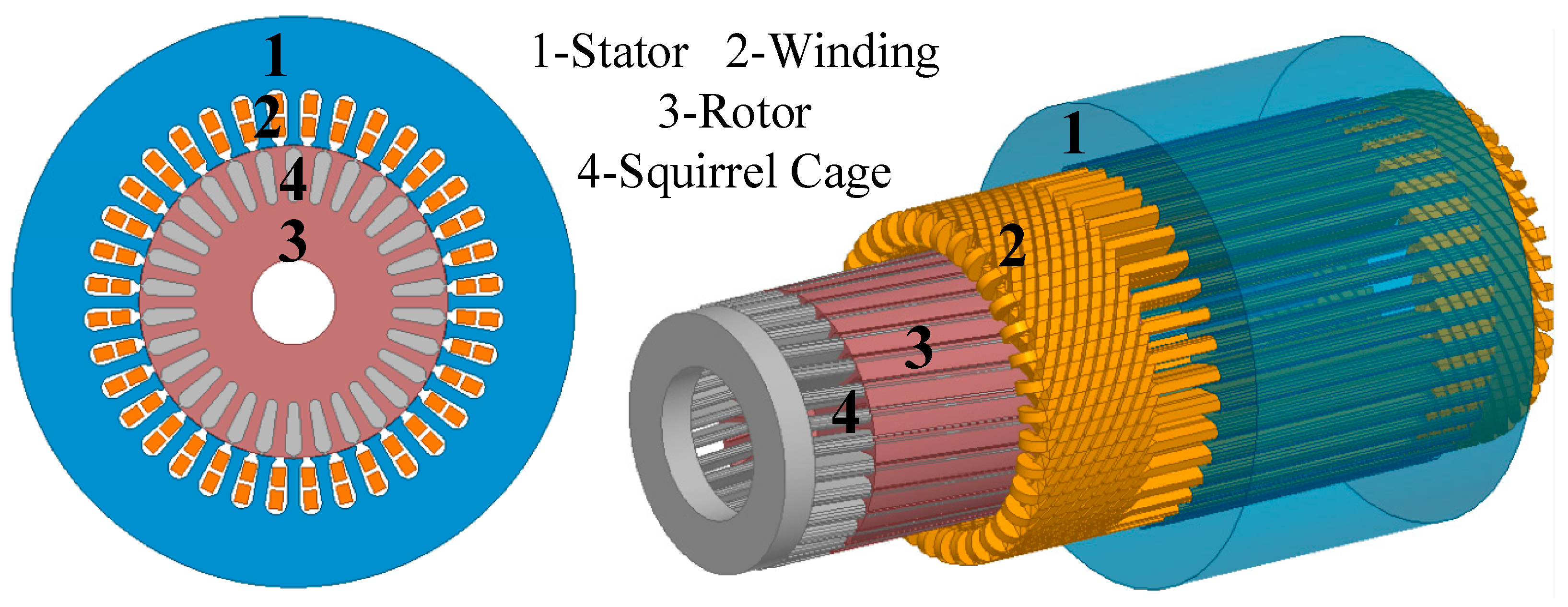
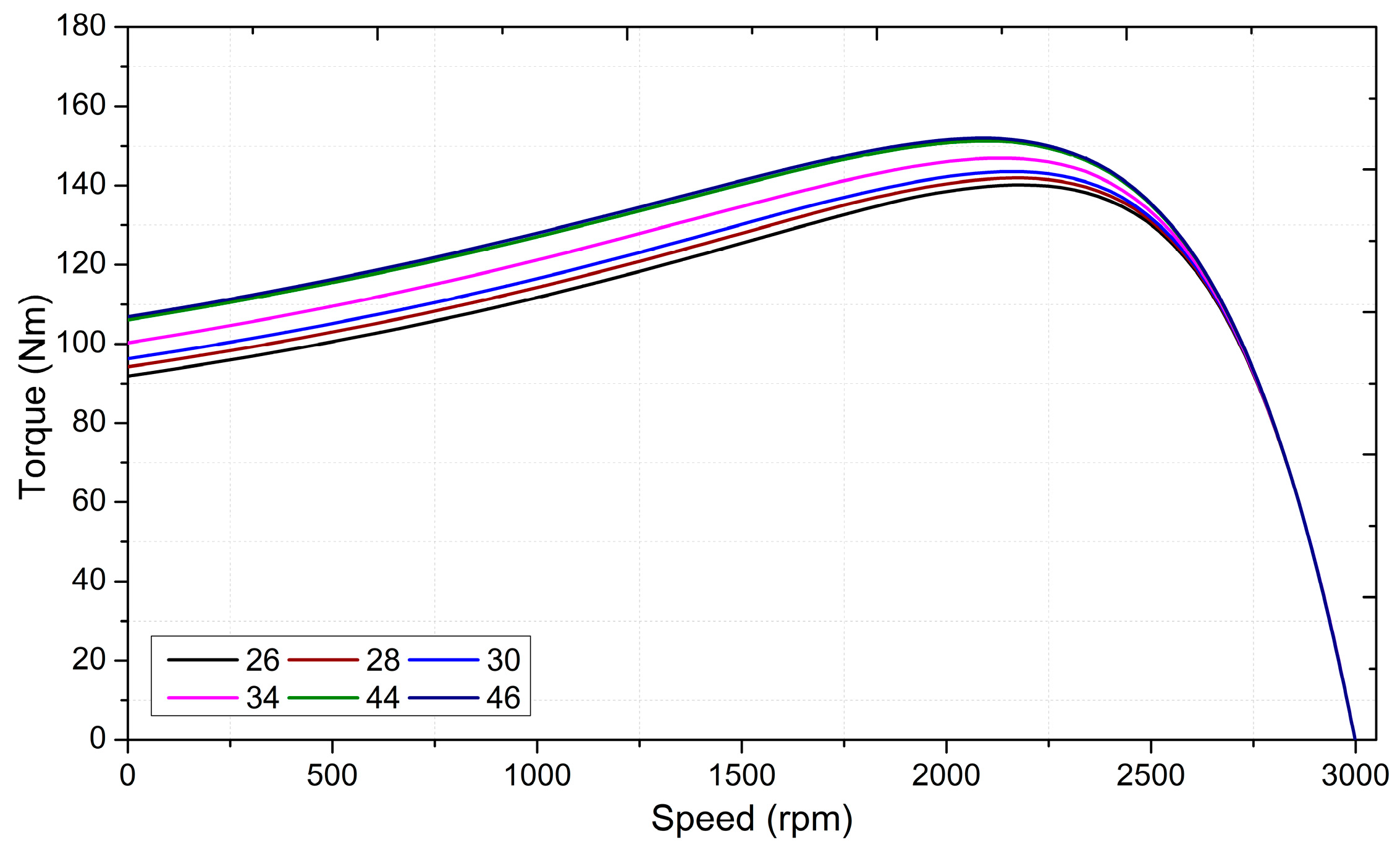

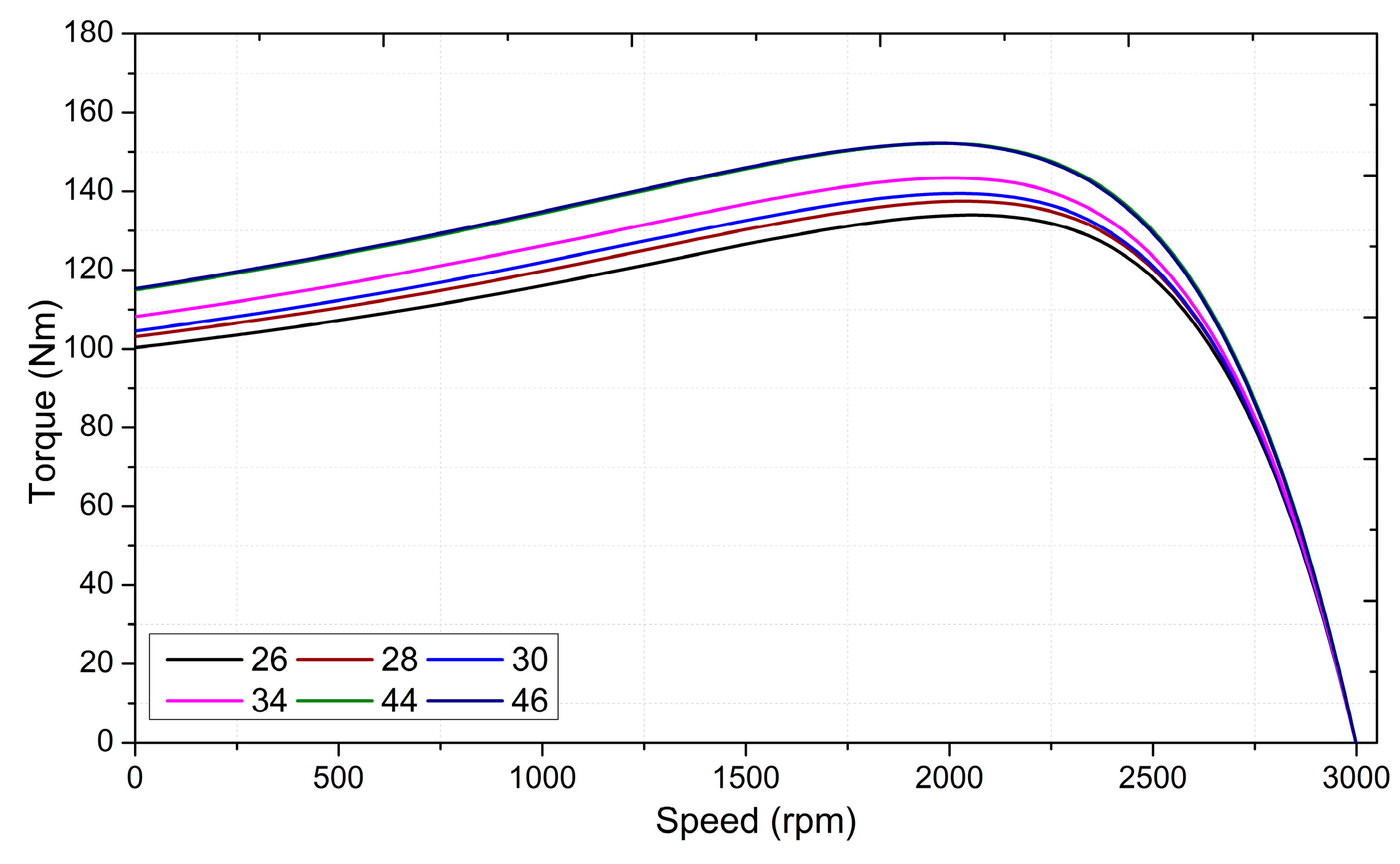

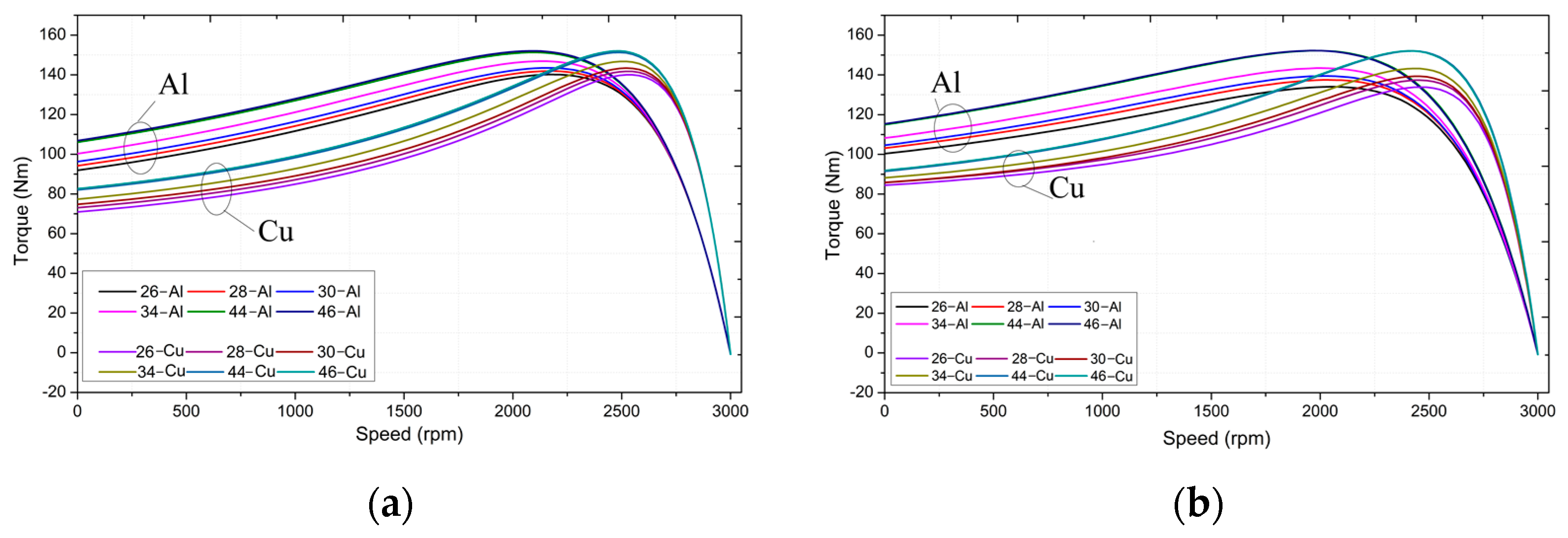
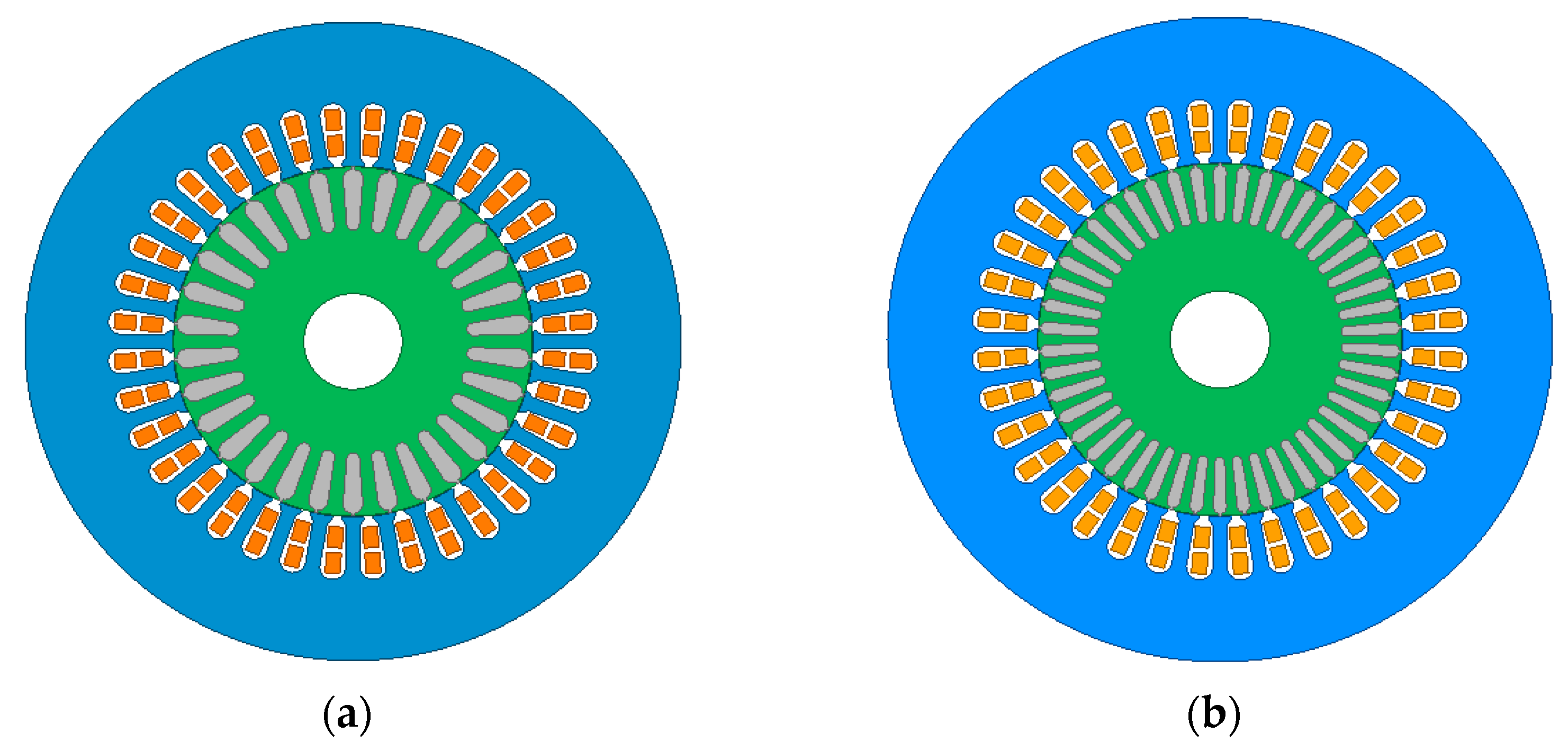
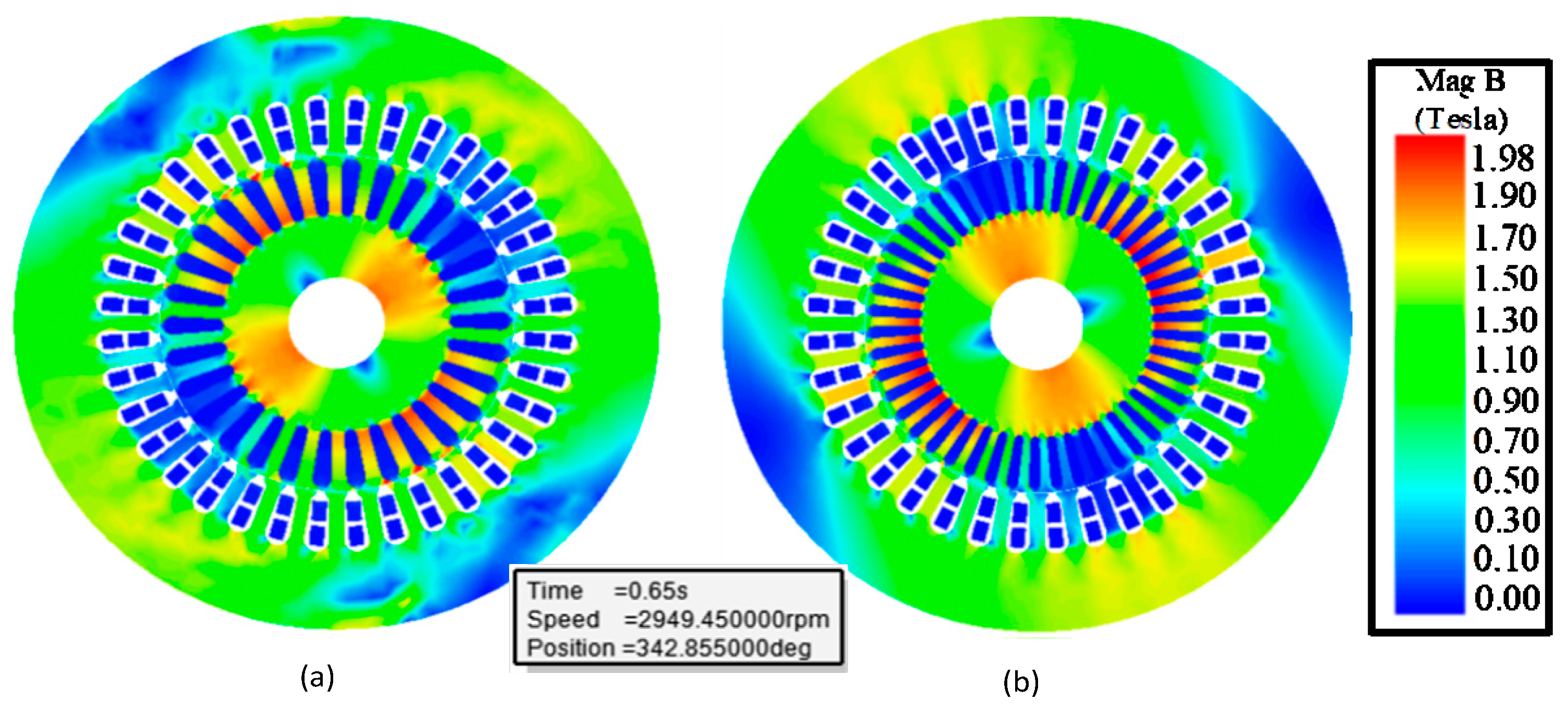
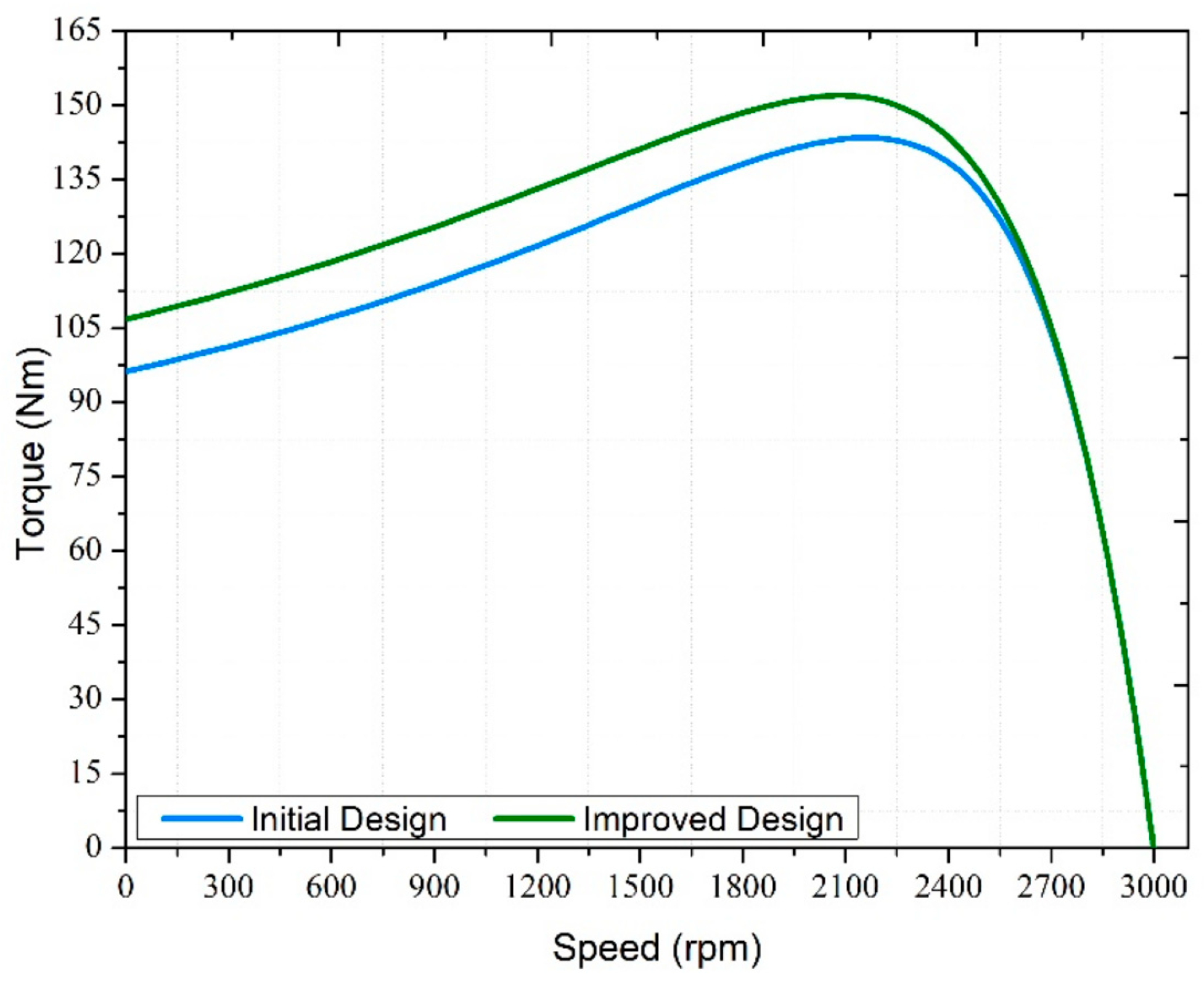
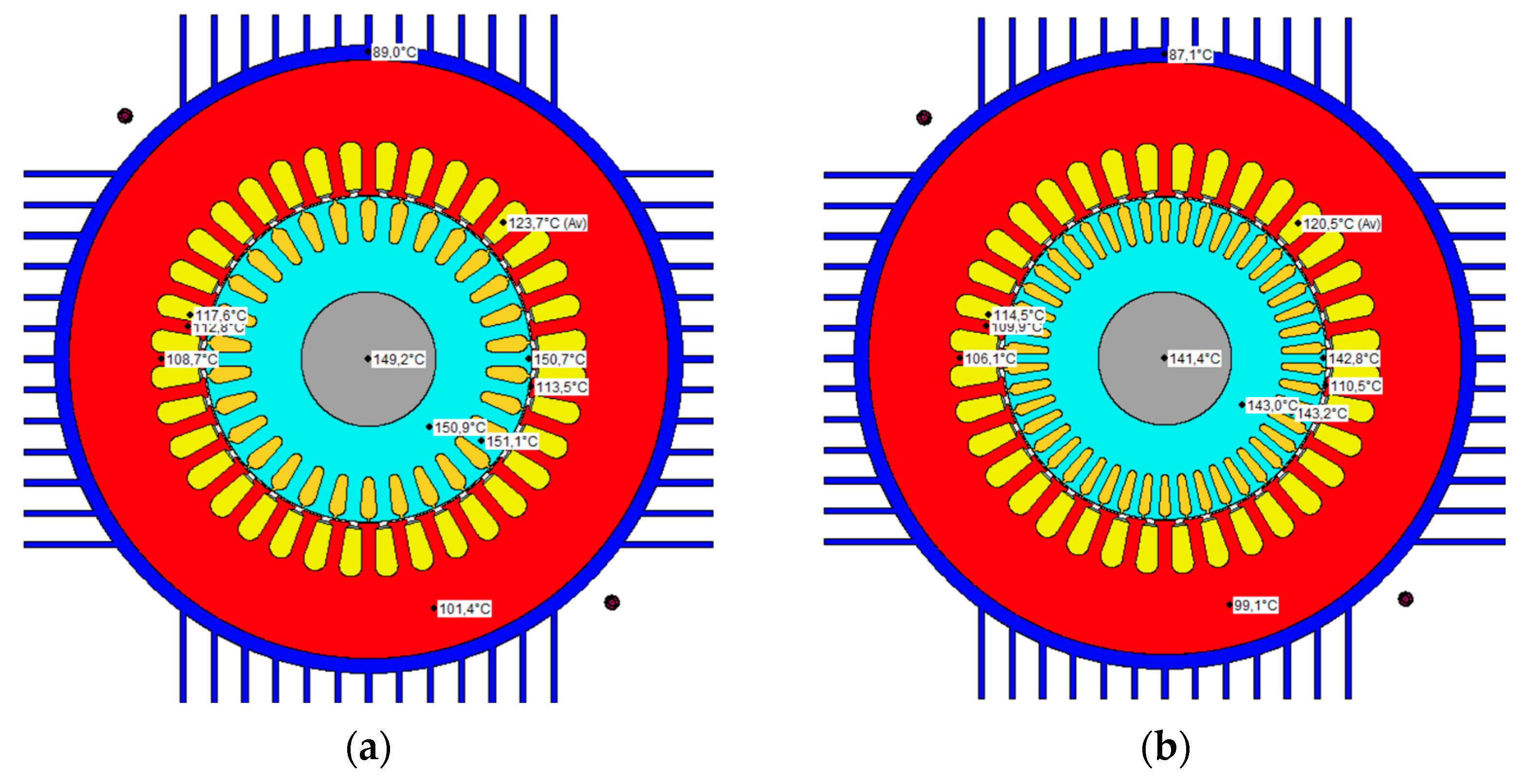
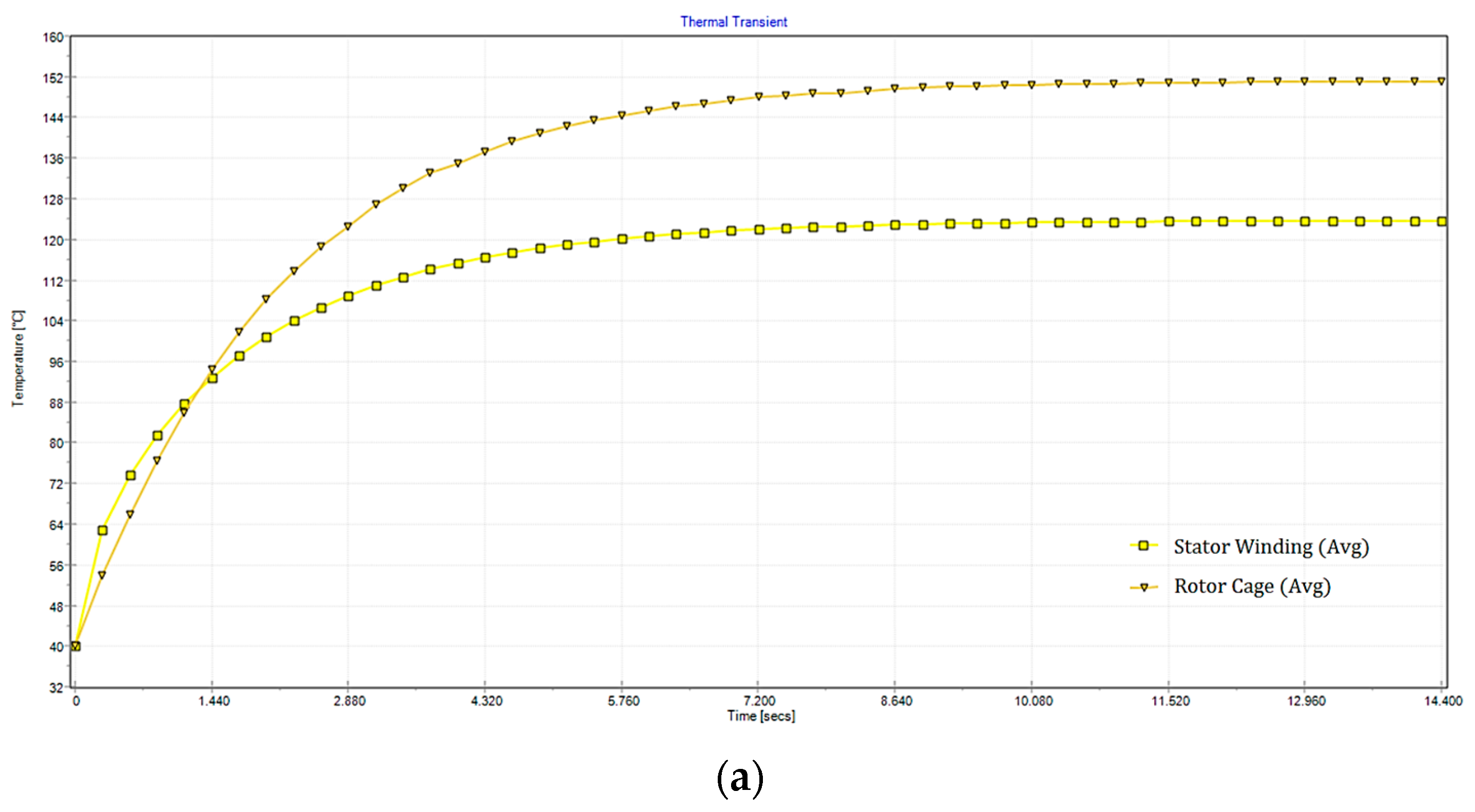
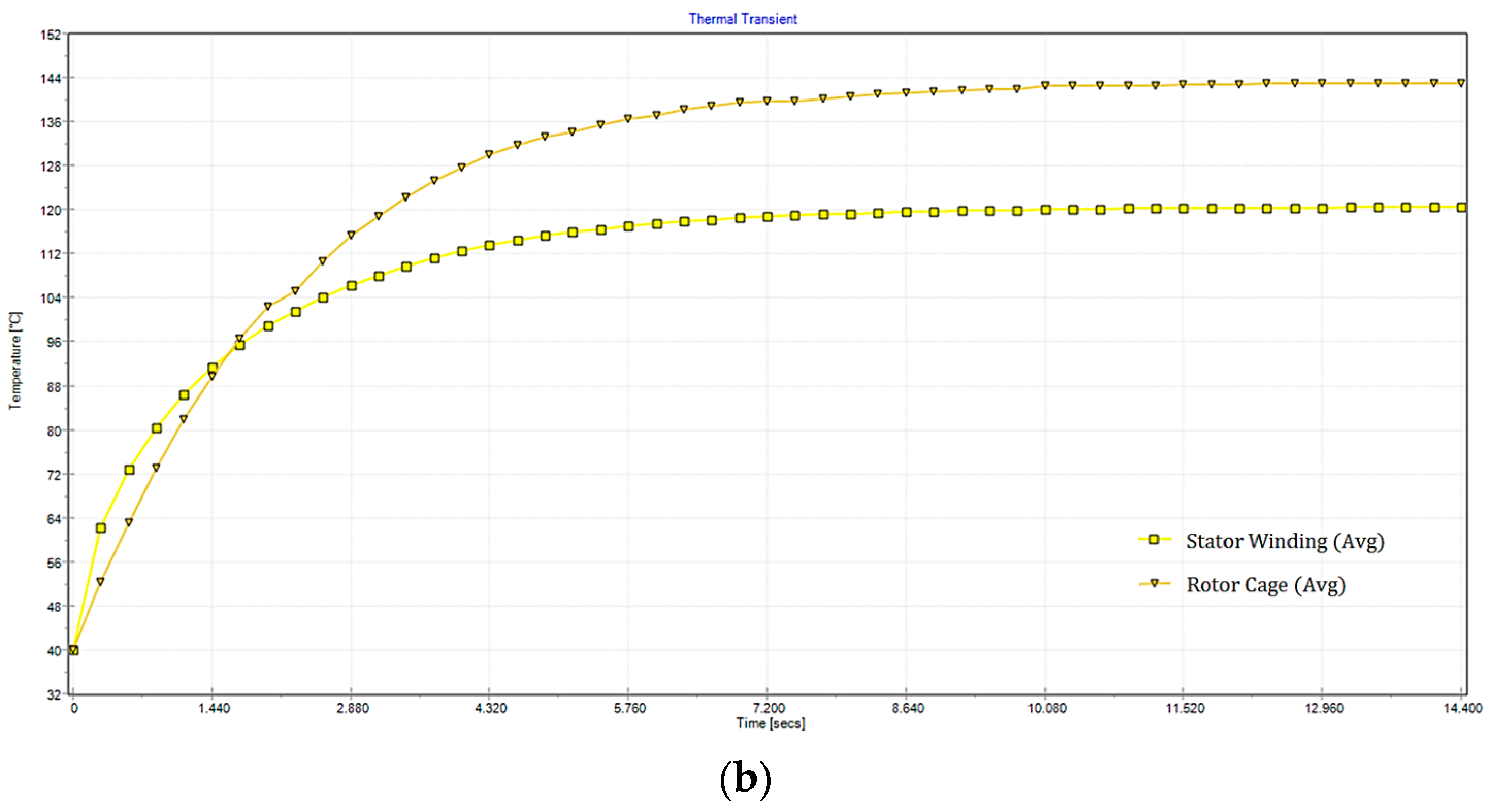
| Parameter | Value | |
|---|---|---|
| Motor type | 3 phase, squirrel cage | |
| Output power | 7.5 kW | |
| Rated frequency | 50 Hz | |
| Number of poles | 2 | |
| Rated speed | 2949 rpm | |
| Slot fill factor | 53.52% | |
| Stator | Outer diameter | 200 mm |
| Inner diameter | 110 mm | |
| Length | 140 mm | |
| Number of slots | 36 | |
| Skew width | 0 | |
| Number of conductors per slot | 28 | |
| Type of Steel | M530-50A | |
| Rotor | Outer diameter | 109.4 mm |
| Inner diameter | 35 mm | |
| Length | 140 mm | |
| Number of slots | 30 | |
| Skew width | 1 | |
| Type of Steel | M530-50A | |
| Squirrel-cage material | Aluminum |
| Number of ST/RT Slots | Rated Load Efficiency (%) | Rated Load Losses (W) | Rated Load Power Factor | Stator/Rotor Current Density (A/mm2) | Rated Torque (Nm) | Starting Torque (Nm) | Total Weight (kg) |
|---|---|---|---|---|---|---|---|
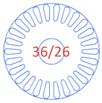 | 86.61 | PTotal: 1159.6 PCore: 321.7 PSt_Cu: 320.8 PRt_Cu: 133 Pf&w: 241.6 PStray: 142.5 | 0.880 | 4.85/2.47 | 24.28 | 91.88 | 30.20 |
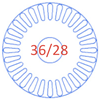 | 86.64 | PTotal: 1155.6 PCore: 321.4 PSt_Cu: 316.8 PRt_Cu: 133.3 Pf&w: 241.6 PStray: 142.5 | 0.885 | 4.82/2.49 | 24.29 | 94.21 | 30.22 |
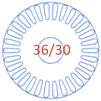 | 86.67 | PTotal: 1153.4 PCore: 321.6 PSt_Cu: 314.4 PRt_Cu: 133.3 Pf&w: 241.6 PStray: 142.5 | 0.888 | 4.81/2.51 | 24.28 | 96.26 | 30.24 |
 | 86.73 | PTotal: 1147.3 PCore: 320.7 PSt_Cu: 308.5 PRt_Cu: 134 Pf&w: 241.6 PStray: 142.5 | 0.896 | 4.76/2.54 | 24.28 | 100.27 | 30.26 |
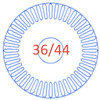 | 86.79 | PTotal: 1140.7 PCore: 321 PSt_Cu: 301.2 PRt_Cu: 134.5 Pf&w: 241.5 PStray: 142.5 | 0.906 | 4.70/2.58 | 24.28 | 106.04 | 30.29 |
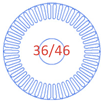 | 86.80 | PTotal: 1140.5 PCore: 321.1 PSt_Cu: 300.9 PRt_Cu: 134.5 Pf&w: 241.5 PStray: 142.5 | 0.907 | 4.70/2.58 | 24.28 | 106.83 | 30.29 |
| Number of ST/RT Slots | Rated Load Efficiency (%) | Rated Load Losses (W) | Rated Load Power Factor | Stator/Rotor Current Density (A/mm2) | Rated Torque (Nm) | Starting Torque (Nm) | Total Weight (kg) |
|---|---|---|---|---|---|---|---|
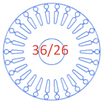 | 86.31 | PTotal: 1189 PCore: 317.5 PSt_Cu: 325.3 PRt_Cu: 164 Pf&w: 239.7 PStray: 142.5 | 0.878 | 4.88/3.49 | 24.38 | 100.32 | 30.58 |
 | 86.36 | PTotal: 1184.4 PCore: 317.7 PSt_Cu: 321.8 PRt_Cu: 162.5 Pf&w: 239.9 PStray: 142.5 | 0.882 | 4.86/3.42 | 24.37 | 103.13 | 30.56 |
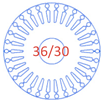 | 86.41 | PTotal: 1178.5 PCore: 318 PSt_Cu: 316.1 PRt_Cu: 162 Pf&w: 239.9 PStray: 142.5 | 0.889 | 4.81/3.45 | 24.37 | 104.54 | 30.57 |
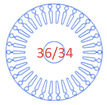 | 86.48 | PTotal: 1171.8 PCore: 318.4 PSt_Cu: 311.9 PRt_Cu: 159 Pf&w: 240 PStray: 142.5 | 0.894 | 4.78/3.37 | 24.36 | 108.17 | 30.54 |
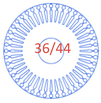 | 86.55 | PTotal: 1164.7 PCore: 319.5 PSt_Cu: 311.9 PRt_Cu: 150.2 Pf&w: 240.6 PStray: 142.5 | 0.894 | 4.78/3.09 | 24.33 | 114.95 | 30.42 |
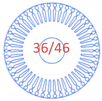 | 86.60 | PTotal: 1160.6 PCore: 319.1 PSt_Cu: 306.8 PRt_Cu: 151.7 Pf&w: 240.5 PStray: 142.5 | 0.9 | 4.75/3.15 | 24.34 | 115.34 | 30.45 |
| Aluminum Cage (36/46) | Copper Cage (36/46) | |||
|---|---|---|---|---|
| Single Cage | Double Cage | Single Cage | Double Cage | |
| Rotor ohmic losses (W) | 134.54 | 151.71 | 75.41 | 84.87 |
| Rotor resistance (Ω) | 0.8604 | 0.9651 | 0.4895 | 0.5491 |
| Efficiency (%) | 86.80 | 86.60 | 87.38 | 87.26 |
| Starting torque (Nm) | 106.83 | 115.34 | 82.63 | 91.85 |
| Rated torque (Nm) | 24.28 | 24.34 | 24.09 | 24.13 |
| Total net weight (kg) | 30.29 | 30.45 | 33.71 | 33.46 |
| Description | Rotor Structure | |
|---|---|---|
| Initial Design (36/30) | Improved Design (36/46) | |
| Efficiency (%) | 86.6 | 86.8 |
| Rotor teeth flux density (T) | 1.783 | 1.786 |
| Rated torque (Nm) | 24.28 | 24.28 |
| Starting torque (Nm) | 96.26 | 106.83 |
| Total weight (kg) | 30.24 | 30.29 |
Disclaimer/Publisher’s Note: The statements, opinions and data contained in all publications are solely those of the individual author(s) and contributor(s) and not of MDPI and/or the editor(s). MDPI and/or the editor(s) disclaim responsibility for any injury to people or property resulting from any ideas, methods, instructions or products referred to in the content. |
© 2023 by the author. Licensee MDPI, Basel, Switzerland. This article is an open access article distributed under the terms and conditions of the Creative Commons Attribution (CC BY) license (https://creativecommons.org/licenses/by/4.0/).
Share and Cite
Ocak, C. A FEM-Based Comparative Study of the Effect of Rotor Bar Designs on the Performance of Squirrel Cage Induction Motors. Energies 2023, 16, 6047. https://doi.org/10.3390/en16166047
Ocak C. A FEM-Based Comparative Study of the Effect of Rotor Bar Designs on the Performance of Squirrel Cage Induction Motors. Energies. 2023; 16(16):6047. https://doi.org/10.3390/en16166047
Chicago/Turabian StyleOcak, Cemil. 2023. "A FEM-Based Comparative Study of the Effect of Rotor Bar Designs on the Performance of Squirrel Cage Induction Motors" Energies 16, no. 16: 6047. https://doi.org/10.3390/en16166047
APA StyleOcak, C. (2023). A FEM-Based Comparative Study of the Effect of Rotor Bar Designs on the Performance of Squirrel Cage Induction Motors. Energies, 16(16), 6047. https://doi.org/10.3390/en16166047






